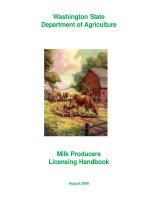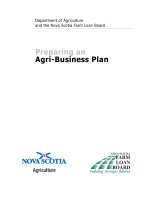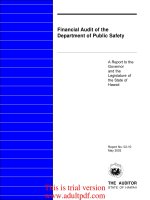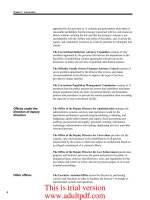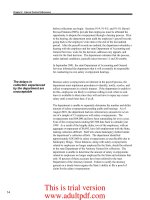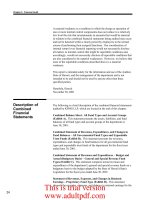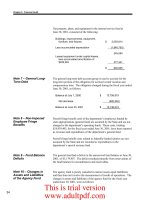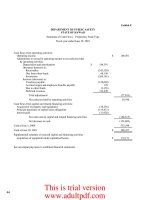Cultivating citrus Directorate Agricultural Information Services, Department of Agriculture in cooperation with ARCInstitute for Tropical and Subtropical Crops
Bạn đang xem bản rút gọn của tài liệu. Xem và tải ngay bản đầy đủ của tài liệu tại đây (905.67 KB, 16 trang )
2009
2003 Second print
2000 First print
Compiled by
Directorate Agricultural Information Services, Department of Agriculture
in cooperation with ARC-Institute for Tropical and Subtropical Crops
Printed and published by
Department of Agriculture
Obtainable from
Resource Centre, Directorate Agricultural Information Services
Private Bag X144, Pretoria, 0001 South Africa
The enjoyment from a home fruit garden depends largely on the condition and general
appearance of the trees. Purchase young trees from a nursery that is registered with
the South African Citrus Improvement Scheme. Trees should not be too old or too big,
otherwise they are likely to be pot-bound.
Climatic requirements
•• Citrus trees are subtropical in origin and cannot tolerate severe frosts. Citrus
production in South Africa is therefore confined to areas with mild and almost
frost-free winters where temperatures seldom (not more than once in several
years) drop below –2 °C and almost never below –3 °C. The average minimum
temperature for the coldest month should not be below 2 to 3 °C if no protection
is provided.
•• Moisture is also a limiting factor in citrus production. Because rainfall is often poorly
distributed and in most cases deficient, it is necessary to supplement moisture by
irrigation to ensure that moisture stress does not suppress growth and production.
Temperature prior to flowering
•• Citrus (except lemons) require shorter days and cooler temperatures in winter for
a normal production rhythm.
•• Flowering should occur almost
exclusively in spring, and these
spring flowers should produce
a large fruit crop 7 to 12 months
later, depending on the cultivar.
In more tropical areas the
flowering pattern is much less
clearly defined and main-season
crops tend to be considerably smaller.
1
•• In South Africa the winters are generally cold enough for good in-season crops
(especially Valencias and grapefruit) to set.
•• Navel trees, however, tend to set smaller crops in the warmer parts of
the local citrus areas. The coldest month in most of the better navel
areas tends to have a mean temperature of 12 to 13 °C.
For the tree to become dormant, the mean temperature
must be below 13 °C. Navels, therefore, need to
approach dormancy in winter. The chances of
producing consistently good crops diminishes
progressively as the mean temperature for the
coldest month rises above 14 °C.
Soil requirements
Citrus can be grown in a wide range of soil types provided
they are well drained. Fertile, well-aerated soils with a pH of
between 6 and 6,5 are ideal.
The growth, development and production of a plant depend on the physical
characteristics of the soil such as drainage, density, texture, water-holding capacity,
structure, soil depth, the homogeneity of the profile, erodibility, and the degree to which
water can infiltrate the soil. These characteristics differ in the various soil types.
Physical soil properties determine the degree to which water is released for uptake by
the plant roots, and the depth of the root system.
Influence of physical soil properties on the development of citrus trees
Root development
The roots of citrus trees normally grow to a depth of 1 m and spread to 2 m beyond the
dripline of the tree.
Certain factors, such as a rock or gravel layer, a mottled clayey soil or a sandy mottled
layer could, however, limit the normal spread of the roots.
If any limiting layers are found within 1 m of the soil surface, the effective soil depth
for the development of plant roots will be restricted to the depth at which the upper
boundary of the restrictive layer occurs. A greater effective depth will cause an
increase in plant yield and growth, because a greater volume of soil can be exploited
by the plant roots.
Root development can also be restricted by a low availability of water and nutrients.
2
Water supply
Water supplied through rain or irrigation is absorbed by the fine particles in the soil and
is therefore available for absorption by plant roots.
Oversaturation or waterlogging occurs in soils that have a layer which restricts the
drainage of water. Such layers can be identified by one or more of the following
characteristics:
••
••
••
••
••
••
••
Grey or yellowish-grey colour
Abundant yellow-brown or reddish-brown mottles
Soft and hardened mottles (concretions)
Prismatic or columnary structure
Strongly developed block structure
Very clayey
Stratified rock layers.
An ideal citrus soil will, in respect of optimum water provision, have the following
characteristics:
•• Red, yellow-brown or brown colour
•• Clayey content of 10 to 40 %
•• No clayey, mottled or structural layers within 1 m of the soil surface.
Layout of citrus orchards
Before planting an orchard it is advisable to provide irrigation facilities such as pipelines
or concrete canals. At present the dragline sprinkler irrigation system and the basin
system for flood irrigation are regarded as the most suitable for citrus orchards.
Planting systems
The square and rectangular planting systems applicable to citrus orchards are
illustrated on page 36.
With the exception of the square system, which is preferable where sprinkler irrigation
is used, the rectangular system is at present favoured above other systems because
the smaller planting distance in the tree rows increases the number of trees per hectare.
Planting
•• Early spring is the best time for transplanting. Planting holes of 0,5 x 0,5 x 0,5 m
are prepared and the soil mixed well with 2 spadefuls of compost or kraal manure
and 250 g of superphosphate.
3
Valencias: A = 7,0 m
A
Navels:
A = 7,0 m
Grapefruit: A = 7,0–8,0 m
A
Schematic illustration of the square planting system
Navels:
A
A = 7,0 –7,5 m
B = 6,0–6,5 m
Valencias: A = 7,0 –7,5 m
B = 6,5–7,0 m
B
Grapefruit: A = 7,0–8,0 m
B = 6,0–7,0 m
Lemons:
A = 6,0–7,0 m
B = 5,0–5,5 m
Schematic illustration of the rectangular planting system
•• The young trees are planted to the same depth as they were in the nursery. Keep
in mind that loose soil tends to compact. The bud union should be about 300 mm
above the ground.
•• Once the tree has been planted, the soil must be firmly tramped down. A basin for
irrigation is made around the tree which must be thoroughly irrigated immediately
after planting. Irrigate again the following day to seal any cracks in the soil.
4
Basin for water
Topsoil
Soil level
Space to be filled
with topsoil
Loose soil
Planting depth for citrus tree
Irrigation
During the first 6 months the trees should be irrigated twice a week and thereafter
every 7 days. The irrigation basin should be gradually enlarged as the tree grows, so
that it is always slightly bigger than the dripline of the tree. Be careful not to damage
the fine superficial feeder roots.
The water required depends on weather conditions. Saturated and poorly-drained
conditions could result in root rot, which will shorten the life of the trees. On the other
hand, a shortage of water may have the following effects:
•• Moisture stress during early spring while the tree is flowering, could result in
excessive drop of flowers and fruitlets, and the resulting crop will be small.
A serious drought followed by good rains could produce out-of-season
flowering and fruit setting.
•• A lack of moisture during October to January could result in acid fruit.
Do not wait for symptoms of water stress before applying water. A tree can suffer from
stress well before any visible signs appear. A slight leaf wilt is a sign of a lack
of water and this must be prevented.
If a sprinkler is used, about 30 mm of water must be applied every 7 days, depending
on the weather.
5
Leaf sampling
Leaf samples must be taken during the following periods:
•• Easy peelers
– end of February
•• Navels and grapefruit
– middle of March
•• Midseasons and Valencias – middle of April
A leaf sample should represent an orchard smaller than 3 ha in which the soil is
homogeneous. If soil variations occur, separate samples must be taken. To ensure
that a good, representative sample is obtained, 3 to 4 leaves per tree from about
20 trees (60–80 leaves) should be sampled evenly through an orchard. Leaves
should not be picked from the same side of the tree. Mature 5 to 7-month-old leaves
are picked behind the fruit on the fruiting stem.
Important factors when sampling leaves:
•• Different cultivars should be sampled separately.
•• Leaf samples must only be taken from bearing trees.
•• Leaves should preferably be sampled in the morning when the dew has dried off.
•• Leaves must be free of sunburn, disease symptoms or insect damage.
•• Leaves should be gathered in clean, new paper bags.
•• The bag should be tightly sealed after sampling. If the samples cannot be delivered
immediately, the bag should be kept in a refrigerator (not a freezer).
•• Samples must be delivered to the laboratory for analysis within 2 days of sampling.
Samples dispatched by post will not be suitable for analysis.
•• Every sample must be
accompanied by a completed
questionnaire, as this
information is important for
recommendation purposes.
Questionnaires are available
from the Analysis Service,
ITSC, Nelspruit.
Sample this leaf
•• Leaf samples should be
taken annually from the
same trees (mark trees
with paint).
Mature 5 to 7-month-old leaves behind fruit on
fruiting stem are picked for leaf sampling
6
Soil analysis
•• A soil-analysis report of a certain orchard can only be reliable if the soil samples
which are analysed are representative of the particular orchard.
•• Soil should be sampled at the same time as the leaves.
•• It is important that the samples taken represent a homogeneous field or orchard.
•• A soil analysis merely indicates the chemical composition of the soil; physical
problems such as waterlogging and plough-soles can only be determined by
means of profile holes.
Method of sampling
If a soil auger is not available, a spade may be used.
Depth
Topsoil:
0 to 200 or 300 mm
Subsoil: 300 to 500 mm
Number of samples
A sample must consist of at least 10 subsamples, representing an area of not more
than 3 ha. Samples from different orchards should not be combined.
Sampling points
The samples should be taken evenly by moving diagonally from the corners through
the orchard. Samples should be taken under the drip area of the trees (in tree basins).
Mixing and packing
•• The subsamples taken from a certain orchard should be placed in a clean
container (not a fertiliser bag) and thoroughly mixed.
•• A sample of about 2 kg is taken from the composite sample and put into a strong,
clean plastic bag.
•• Every sample must be clearly marked.
•• In addition to the name of the producer, the number of the orchard, sample number
and the depth at which it was taken should be indicated on the label.
•• Attach the label to the outside of the container. If placed inside the container it
might become illegible.
•• Send the sample to the nearest soil analysis laboratory.
7
Fertilisation
During the first year, nitrogen may be applied every 2 months. Any of the following
nitrogen fertilisers may be applied:
•• 6 applications of 25 g limestone ammonium nitrate (LAN 28 %) per tree per year
or
•• 6 applications of 16 g urea (46 %) per tree per year
or
•• 6 applications of 36 g ammonium sulphate (21 %) per tree per year (one matchbox
full of fertiliser is roughly 36 g).
From the second year, nitrogen must be applied twice a year, half in July and half in
March. Fertiliser should be spread evenly under the canopy of the tree and irrigated.
Very deep irrigations will wash the fertiliser down too deeply and out of reach of the
shallow feeder roots.
Phosphorus may be applied at any time of the year. One application should be
sufficient. Potassium should also be applied once, early in spring.
The table indicates how the fertiliser requirements of growing citrus trees increase.
Fertiliser requirements of young citrus trees (kg/tree/year)
Age
Fertiliser mixtures
Type of fertiliser
3:1:5 (38)
5:1:5 (45)
LAN
Supers
(28)
(10,5)
Potassium
chloride
(50)
1
0,5
-
0,15
0,20
0,20
2
0,9
-
0,30
0,40
0,20
3
1,3
-
0,50
0,60
0,30
4
1,8
-
0,75
0,80
0,50
5-6
-
2,0
1,20
1,00
0,75
7-8
-
2,5
1,80
1,25
1,00
9+
-
3,0
2,10
1,50
1,50
It is often necessary to apply micronutrients. These elements are dissolved in water
and applied as a spray onto the tree. Deficiencies of zinc, copper and manganese
often occur and may be applied in 10 l water at the following concentrations:
•• 15 g zinc oxide
•• 20 g copper oxychloride
•• 20 g manganese sulphate.
8
The micronutrient solutions should be sprayed during early spring when the leaves are
actively growing. A boron deficiency can be rectified by spreading 20 g borax per large
tree under the canopy or by spraying with a solution of 10 g solubor/10 l water.
Pruning
•• Citrus trees are not usually pruned, although dead wood must be removed regularly.
•• To avoid low branches reaching to the ground, trees are skirted soon after the crop
is removed.
•• Branches reaching to the ground hamper the removal of fruit lying underneath the
tree, impede irrigation and promote ant infestation of the trees.
•• When trees become too big and start growing into one another, pruning is
recommended.
Control of pests, plant diseases and weeds
For information on the chemical control of insects, plant diseases and weeds consult
the latest issues of:
•• A guide for the control of plant pests
•• A guide for the control of plant diseases
•• A guide to the use of herbicides
These publications are published by the national Department of Agriculture and
obtainable from the Resource Centre, Directorate Agricultural Information Services,
Private Bag X144, Pretoria 0001.
Pests
The use of pesticides in the home garden should be restricted to a minimum. There
is a balance between pests and their natural enemies. When pesticides are used
injudiciously, this balance is disturbed and a vicious cycle is created. The result is
that these few trees have to be sprayed regularly. Apart from the cost factor, this
is dangerous because the amateur fruit producer does not normally use protective
equipment such as gloves, overalls or respirators.
Ants
•• Some of the most important insects to be controlled are the
brown house ant and the pugnacious ant.
•• To keep ants out of the trees, insecticides sold under various
trade names can be applied around the tree trunks.
9
•• Ant nests, particularly those of the pugnacious ant, underneath or near the trees
can be treated with registered chemicals.
Red scale
Red scale is controlled satisfactorily by natural enemies, provided ants are kept out of
the trees (see Ants).
Soft brown scale
Soft brown scale secretes a sticky substance, known as honeydew, on the leaves and
fruit. The honeydew subsequently turns black as the result of sooty mould that grows
on it. Soft brown scale is controlled very well by various parasitoids and predators,
provided ants are kept out of the trees (see Ants).
Citrus thrips
Severe attacks by citrus thrips cause young shoots and leaves to become thickened
and distorted. Developing apical shoots may turn black and fall off. During development
the peels of young citrus fruit can also be blemished by citrus thrips. This mostly starts
from the stem-end and may spread downwards extending over the rest of the fruit.
However, it does not affect the eating quality of the fruit.
Orange dog
Orange dog is frequently a problem on young trees because it feeds mainly on the
young leaves. The smaller caterpillars are black with yellow and those that are larger,
green and brown. They can be identified by the unpleasant smell that is exuded when
touched. They can be collected by hand and destroyed.
Citrus psylla
Citrus psylla is the vector and transmitter of a major citrus disease known as greening.
(see Greening under Diseases). Citrus trees have 3 normal growth flushes during the
year: spring growth during August/September, followed by a second in November/
December and the last during February/March. Lemons are, however, the exception
since lemon trees form new leaves throughout the year. It is during these flushes that
the trees are subject to psylla infestation. It is therefore important to examine the trees
thoroughly during these periods to determine the degree of infestation and to organise
control of the pest accordingly.
10
The female lays easily discernible orange-yellow eggs
on the edges of young leaves. When the eggs hatch, the
young nymphs move to the underside of the leaves where
they establish themselves to feed and cause pock-like
malformation of the leaves.
Control of the pest must be aimed at destroying the
nymphs as soon as possible after they have hatched.
Because all the eggs do not hatch simultaneously, it is
essential to use a spray with a fairly long residual action.
Fruit flies
Fruit flies cause post-harvest decay on fruit. The normal control method is to apply
a toxic bait to the leaves of the trees. Applications must commence in February and
continue up to the end of the citrus season. The important period is from February until
the end of June.
False codling moth
Larvae of this moth feed inside the fruit and cause decay. Remove and destroy
all dropped and infested fruit from the trees weekly. Also remove all out-of-season
oranges in November and again once the fruit has been harvested. Infested fruit
serves as a source for reinfestation.
Citrus bud mite
This mite is exceptionally small and hides in the flower and axillary buds. It causes
malformed growth points, flowers and fruit and also peculiarly shaped leaves. The
growth of young trees is seriously hampered and yields can be reduced dramatically.
Young citrus trees up to the age of 10 years, as well as older navel and lemon trees,
should be sprayed once a year to control this pest.
Weeds
It is very important to keep the area under the canopy free of weeds. Nutgrass and
quickgrass, especially, should not be tolerated. Weeds may be removed by hand. Be
careful not to damage the shallow feeder roots or the trunk when spades or other tools
are used. Wounds promote penetration of soil pathogens which cause root rot. Weeds
also act as pathways for ants.
11
Diseases
Citrus black spot
This disease is common in the hot low-lying areas of Mpumalanga and KwaZulu-Natal
and can be controlled effectively with chemical remedies.
Scab
Scab often occurs on rough lemon seedlings. The symptoms are a corky roughness on
the leaves and young twigs. It can be controlled chemically.
Greening
It is an important disease which is prevalent in the relatively cooler, high-lying areas
(above 600 m). Typical symptoms are yellowing of the leaves and malformed fruit. One
side of the fruit along the central axis does not develop normally and remains smaller,
resulting in asymmetrical fruit. The smaller side remains greenish while the rest of
the fruit turns orange. The disease is caused by a bacterium for which no chemical
treatment is available. It is transmitted by psylla (see Citrus psylla).
As greening is usually localised within one or two branches of the tree, it is advisable
to cut out such branches. Saw them off as close to the trunk as possible. If the entire
tree is affected, it would be better to remove and replace it.
For further information contact the
ARC-Institute for Tropical and Subtropical Crops
Private Bag X11208, Nelspruit 1200
Tel: 013 753 7000 • Fax: 013 752 3854
12


